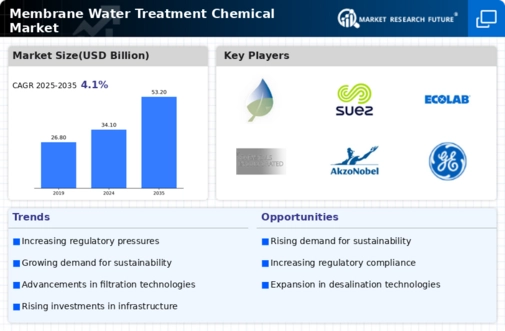Increasing Water Scarcity
The Global Membrane Water Treatment Chemical Market Industry is experiencing growth due to the rising concern over water scarcity. As populations expand and industrial activities increase, the demand for clean water intensifies. For instance, regions such as the Middle East and North Africa are facing severe water shortages, prompting governments to invest in advanced water treatment technologies. This trend is reflected in the market's projected value of 34.1 USD Billion in 2024, indicating a robust response to these challenges. The adoption of membrane technologies is crucial for enhancing water recovery rates, thereby addressing the urgent need for sustainable water management.
Market Growth Projections
The Global Membrane Water Treatment Chemical Market Industry is poised for substantial growth, with projections indicating a market value of 34.1 USD Billion in 2024 and an anticipated increase to 53.2 USD Billion by 2035. This growth trajectory suggests a robust demand for membrane water treatment chemicals, driven by factors such as increasing water scarcity, regulatory pressures, and technological advancements. The compound annual growth rate (CAGR) of 4.12% from 2025 to 2035 further underscores the market's potential. These figures reflect the industry's response to global water challenges and the ongoing need for innovative treatment solutions.
Regulatory Support for Water Quality
Government regulations aimed at improving water quality are driving the Global Membrane Water Treatment Chemical Market Industry. Stricter standards for wastewater discharge and drinking water quality compel industries to adopt advanced treatment solutions. For example, the U.S. Environmental Protection Agency has established guidelines that necessitate the use of effective filtration methods, including membrane technologies. This regulatory landscape is expected to bolster market growth, with projections indicating a rise to 53.2 USD Billion by 2035. The emphasis on compliance with environmental regulations is likely to encourage investments in membrane water treatment chemicals, fostering innovation and efficiency in the sector.
Rising Industrial Demand for Water Treatment
The industrial sector's increasing demand for effective water treatment solutions is a key driver of the Global Membrane Water Treatment Chemical Market Industry. Industries such as pharmaceuticals, food and beverage, and electronics require high-quality water for their processes. The need for reliable water treatment methods to meet production standards is paramount. As a result, companies are investing in membrane technologies to ensure compliance and enhance product quality. This trend is expected to sustain market growth, with the industry projected to reach 34.1 USD Billion in 2024, reflecting the critical role of water treatment chemicals in various industrial applications.
Growing Awareness of Environmental Sustainability
There is a growing awareness of environmental sustainability among consumers and industries, which is positively impacting the Global Membrane Water Treatment Chemical Market Industry. As stakeholders increasingly prioritize eco-friendly practices, the demand for sustainable water treatment solutions rises. This shift is evident in the adoption of green chemistry principles in the formulation of membrane treatment chemicals. Companies are now focusing on reducing the environmental footprint of their operations, which aligns with global sustainability goals. This trend is likely to drive market growth, as organizations seek to implement environmentally responsible water treatment solutions that comply with emerging regulations.
Technological Advancements in Membrane Technologies
Innovations in membrane technologies are significantly influencing the Global Membrane Water Treatment Chemical Market Industry. Advancements such as the development of more efficient membranes and improved chemical formulations enhance the performance and longevity of water treatment systems. For instance, the introduction of nanofiltration and reverse osmosis membranes has revolutionized the treatment processes, allowing for higher purity levels and lower energy consumption. These technological improvements are likely to contribute to a compound annual growth rate (CAGR) of 4.12% from 2025 to 2035, as industries seek to optimize their water treatment operations and reduce operational costs.













